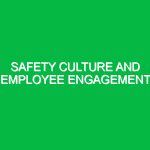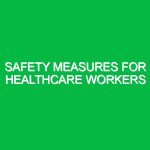In today’s world, where public spaces serve as vital hubs for social interaction, recreation, and commerce, the importance of health and safety cannot be overstated. The Health and Safety Guidelines for Public Spaces are designed to protect individuals from various hazards, ensuring a safe environment for everyone. As we delve into these guidelines, we’ll explore their relevance in the Health, Safety, and Environment (HSE) domain, identify potential risks, and provide actionable safety precautions to enhance public safety.
The Relevance of Health and Safety Guidelines in HSE
Health and Safety Guidelines are critical in the HSE domain as they help mitigate risks associated with public interactions. These guidelines are not just policies; they are frameworks that organizations and local authorities use to create safer environments. They encompass everything from emergency preparedness to disease prevention and environmental protection. As we have witnessed during recent global health crises, the importance of robust health and safety measures is paramount. Not only do they protect individuals, but they also promote public trust and confidence in shared spaces.
Identifying Hazards and Risks in Public Spaces
Public spaces, whether parks, shopping malls, or community centers, are susceptible to various hazards. Understanding these risks is the first step in implementing effective health and safety guidelines.
1. Biological Hazards
Biological hazards include bacteria, viruses, and other pathogens that can spread diseases. For instance, crowded places like public transportation systems often see an uptick in flu and cold infections. A notable example is the COVID-19 pandemic, which highlighted how quickly a virus can spread in public settings.
2. Chemical Hazards
Chemical hazards can arise from cleaning products, pesticides, or pollution. Consider a nearby park where pesticides are regularly applied to maintain greenery. If not managed properly, these chemicals can pose health risks to visitors.
3. Physical Hazards
Physical hazards include slips, trips, and falls, which are common in public areas. Uneven pavement, wet floors, or clutter can lead to accidents. A personal experience comes to mind: while attending a festival in a local park, I witnessed a child trip over a loose cable, which could have been prevented with better signage and hazard awareness.
4. Ergonomic Hazards
Ergonomic hazards are often overlooked but can significantly impact public spaces, especially in areas where people stand for long periods. For example, if queues are poorly managed in a shopping mall, individuals might experience fatigue or injury from prolonged standing.
5. Environmental Hazards
Environmental hazards, such as extreme weather conditions, can also pose risks. During heatwaves, parks can become dangerous for visitors who are not prepared for the heat. It’s essential for public spaces to have measures in place to respond to such conditions.
Safety Precautions and Best Practices
Once we identify potential hazards, the next step is establishing safety precautions. Here are some best practices tailored for public spaces.
1. Promote Hygiene and Sanitation
To manage biological hazards, public spaces must prioritize cleanliness. Regular disinfection of high-touch areas, such as handrails and door handles, is crucial. Additionally, providing hand sanitizing stations can encourage hygiene among visitors. A study conducted by the CDC found that facilities with easily accessible hand sanitizers reported a significant decrease in illness outbreaks.
2. Clear Signage and Communication
Effective communication is vital in preventing accidents. Clear signage indicating wet floors, uneven surfaces, or restricted areas can alert visitors to potential dangers. During my time volunteering at a community event, I noticed that simple signs helped reduce accidents by informing attendees of risks.
3. Training and Awareness Programs
Staff training is essential for maintaining safety in public spaces. Regular workshops on emergency procedures, first aid, and hazard identification can prepare staff to respond effectively to incidents. In a recent case study involving a city park, staff training significantly improved the response time during a medical emergency, showcasing the value of preparedness.
4. Emergency Preparedness Plans
Every public space should have an emergency preparedness plan tailored to its specific risks. This may include evacuation procedures, first aid stations, and communication protocols. Regular drills can help familiarize staff and the public with these plans, ensuring a coordinated response during emergencies.
5. Community Engagement and Feedback
Engaging with the community fosters a sense of ownership and awareness about health and safety. Public forums or surveys can provide insights into community concerns and suggestions for improvement. A local community center recently implemented a feedback system that allowed residents to report safety issues, resulting in timely resolutions and increased trust in the management.
Regulations and Standards Governing Health and Safety in Public Spaces
Several regulations govern health and safety in public environments. Understanding these standards is crucial for compliance and effective implementation.
1. Occupational Safety and Health Administration (OSHA)
In the United States, OSHA provides guidelines to ensure safe working conditions, which extend to public spaces where employees interact with the public. OSHA standards cover everything from emergency action plans to sanitation requirements.
2. Centers for Disease Control and Prevention (CDC)
The CDC offers recommendations specifically related to disease prevention in public areas. Their guidelines became especially relevant during the COVID-19 pandemic, emphasizing the need for social distancing, mask-wearing, and proper sanitation.
3. Local Health Departments
Local health departments often set specific regulations tailored to their communities. These might include guidelines for food safety in public events or requirements for public swimming pools. Staying updated on these regulations is essential for maintaining compliance.
Conclusion
Health and Safety Guidelines for Public Spaces are fundamental in ensuring the well-being of individuals in shared environments. By identifying potential hazards and implementing effective safety precautions, we can create safer spaces for everyone. As we continue to navigate the challenges of public health and safety, it is essential to remain vigilant, informed, and cooperative. The commitment to maintaining these guidelines not only protects individuals but also enhances community trust and engagement.


